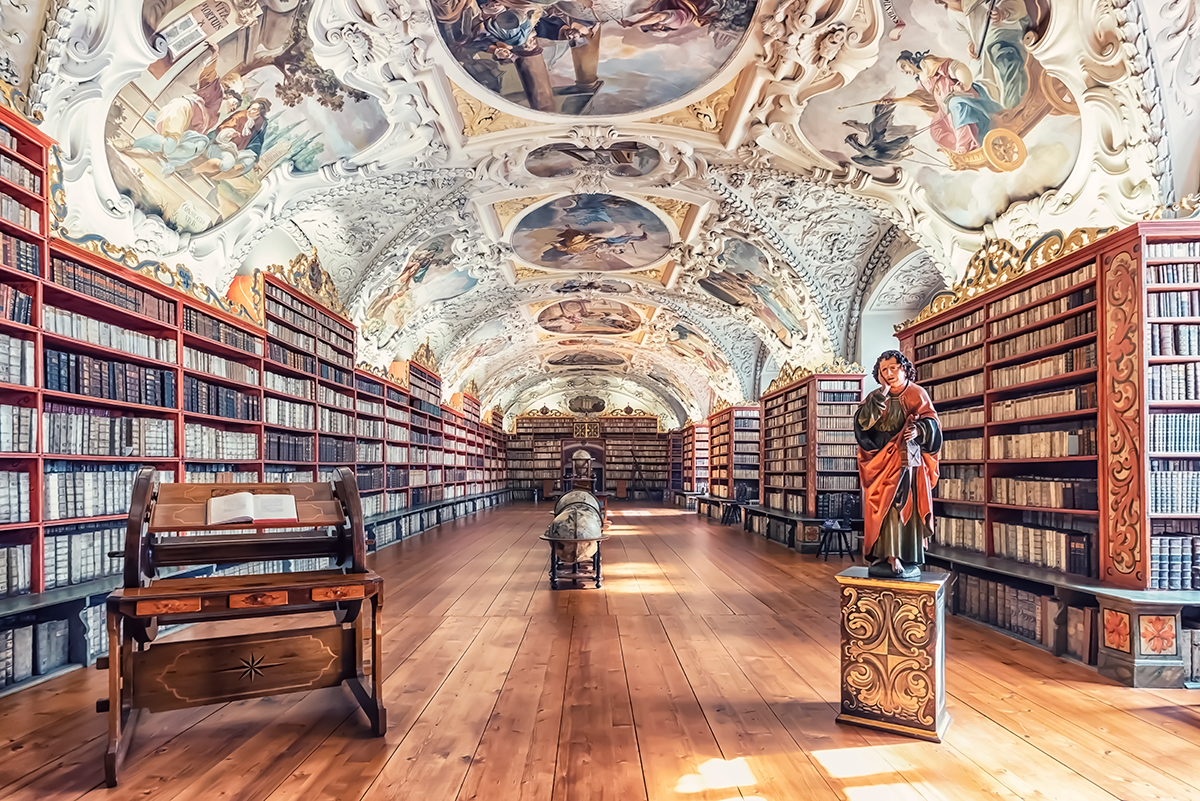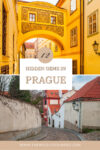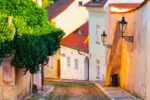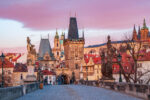Prague has one of the most perfectly preserved old towns in all of Europe. Its streets are lined with spectacular architecture – a bold fusion of medieval sturdiness, renaissance sophistication and baroque exuberance. It is practically an open-air museum of European art and history.
And like in every museum, there are abundant hidden gems in Prague that are so overshadowed by architectural masterpieces that they become hidden in plain sight.
This guide to the hidden gems in Prague reveals some of these gems and doesn’t require straying far from the trodden path. Although many of these hidden corners of Prague provide a much-needed respite from the constant flow of tourist traffic.
By the way, if you enjoy discovering hidden gems, Prague has a couple of fantastic tour options. One is the Medieval Underground & Dungeon Tour, and the second one is the Ghosts and Legends of the Old Town Evening Tour. Both are good quality tours.
Novy Svet Street
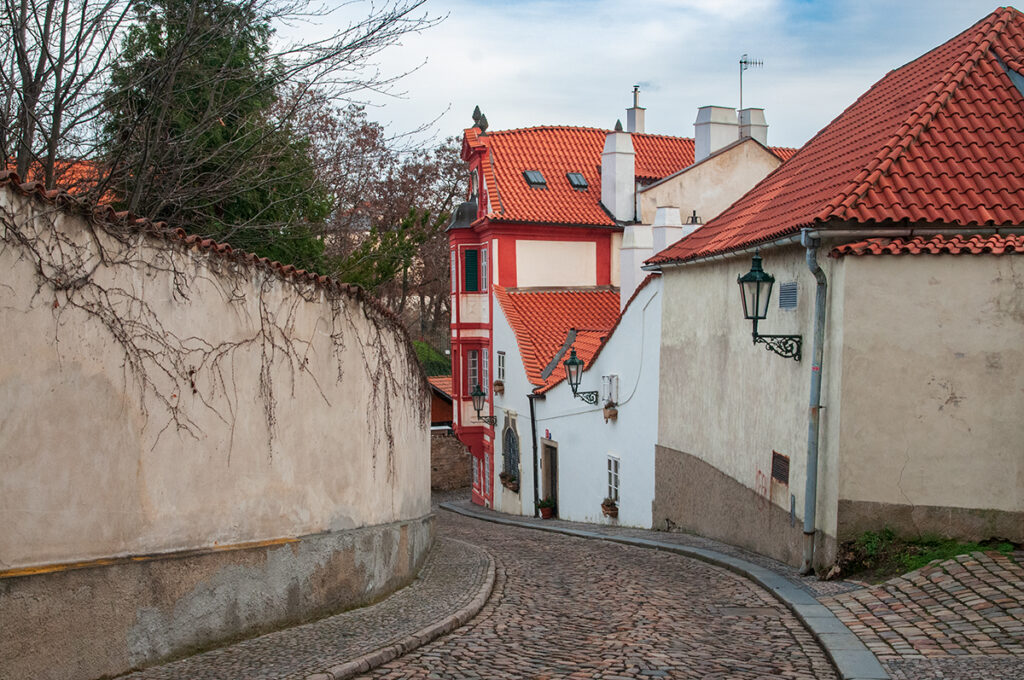
One of my favourite hidden gems in Prague is the gorgeous Novy Svet street, just a couple of streets behind Prague Castle. Considered Prague’s most romantic little street, it feels completely untouched by time. On one side, the street is lined by the old town wall – the houses on this street were just inside the defence walls in the 14th century.
Most of the buildings you see today were built in the 17th and 18th centuries as common people’s houses. Today they are sought-after residences of artists and writers. On the corner of Novy Stet and Cerninska Streets, you’ll find a tiny pink house – one of the smallest in Prague. But if you want to find THE smallest house in Prague, head to the next hidden gem.
The Smallest House in Prague
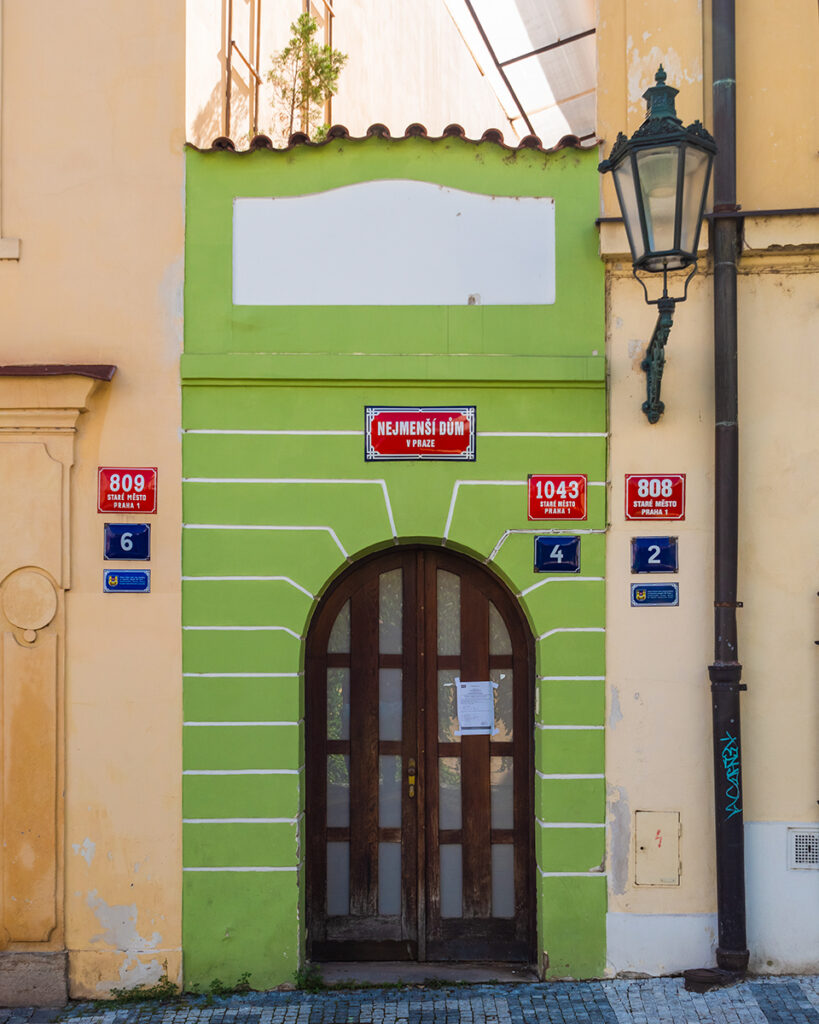
The smallest house in Prague is a tiny green house squeezed between two cream two-story houses on Anežská Street, just a few steps away from St Agnes Convent. Known as Nejmensky Dum, it was built in 1853 in a narrow alley. The 2.25-meter-wide house had only two rooms. Yet, for more than half of its life, the house functioned as a brothel.
The house hasn’t survived the passage of time, and the alley where it stood went back to being an alley behind the charming green facade – the only part of the house that still stands.
The Smallest / Narrowest Hotel in Prague
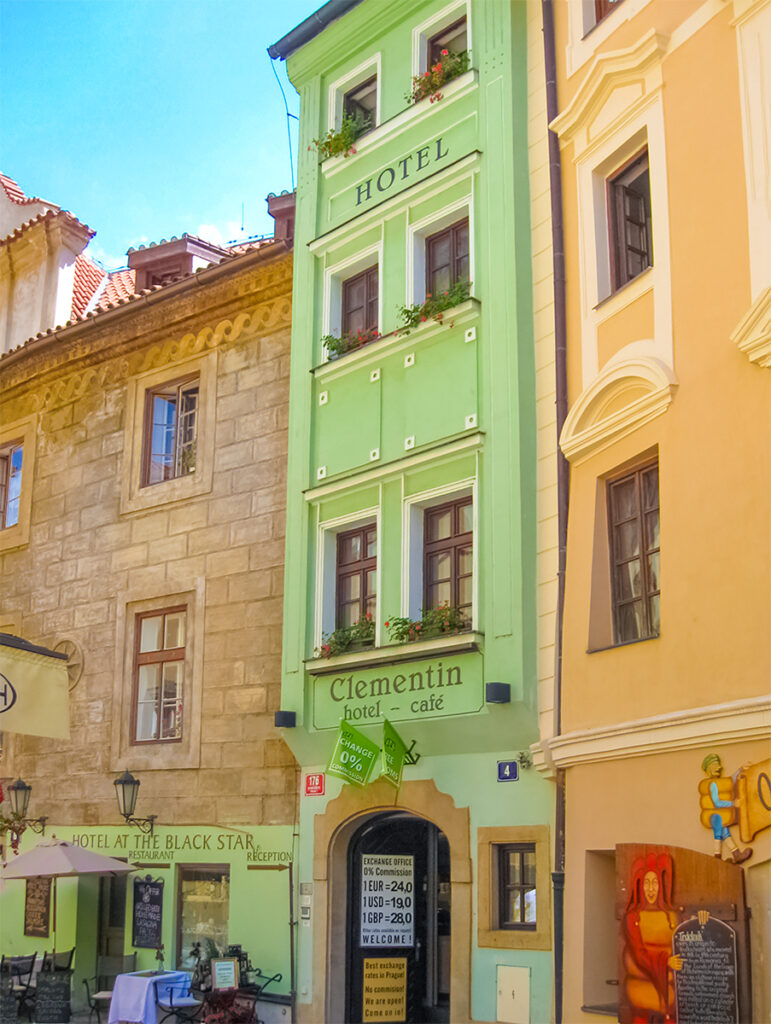
You can however experience what it’s like to be inside a super narrow house, and you can do so in style. The facade of Prague’s luxurious Hotel Clementin, in the heart of Old Town, is only 3,28 m wide.
The history of the house goes all the way back to the mid-1300s. Originally, the house had two stories and was part of the adjacent house. It became an “independent” house in the late 17th century, and this was when the third story was added.
The hotel has nine stylish rooms, a tiny reception, and a small breakfast room. If you are not convinced that the house is barely 3,28 meters wide, there is a measuring tape available at reception just for such an occasion.
The Narrowest Street in Prague
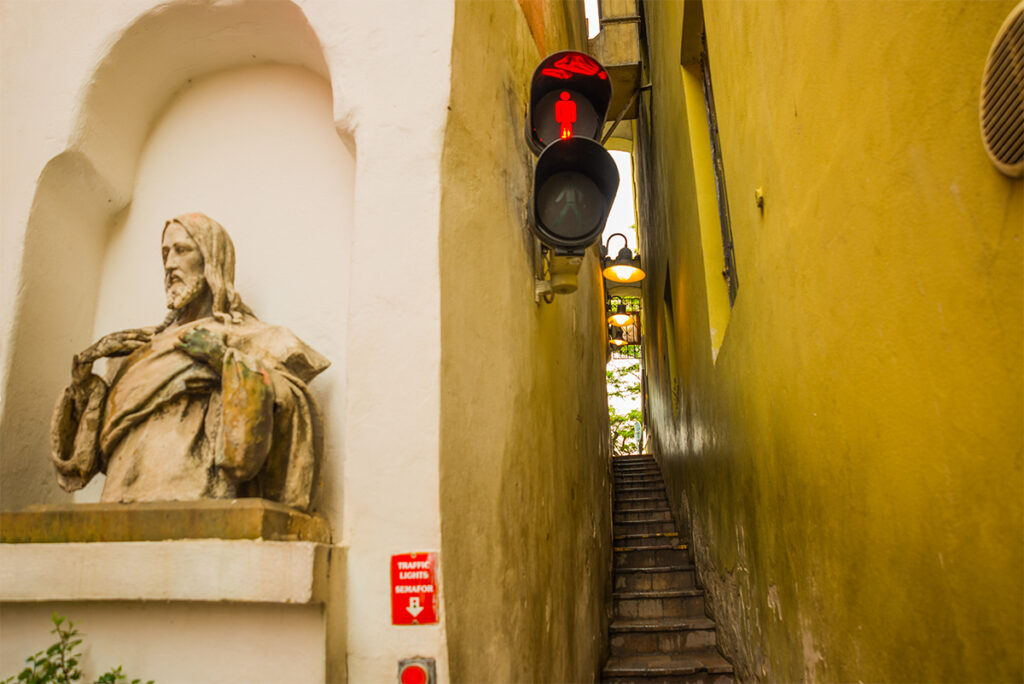
If a 2.25-meter-wide house sounds narrow, consider Vinarna Certovka – the smallest street in Prague. Located just to the right of Charles Bridge, Prague’s oldest neighbourhood, Malá Strana, Vinarna Certovka, is under 50 cm in width. That’s even narrower than the Handkerchief Alley in Cordoba.
In fact, this street is so narrow that two people can’t pass each other. Two traffic lights have been installed on either end of the street to indicate when it is occupied and to regulate pedestrian traffic.
Originally, this passage, which is essentially a flight of stairs between two buildings, served as a fire escape. There were several such passages in Prague, but Vinarna Certovka is the last one remaining. It leads to Certovka Restaurant, but if you are not a fan of tight spaces, you can take a longer way around to the restaurant.
For those who are a bit claustrophobic, the tiny street is easily avoidable. It’s merely a little urban planning quirk and is thankfully not the main way to get to the restaurant tucked away at the end.
Street Signs on Nerudova Street
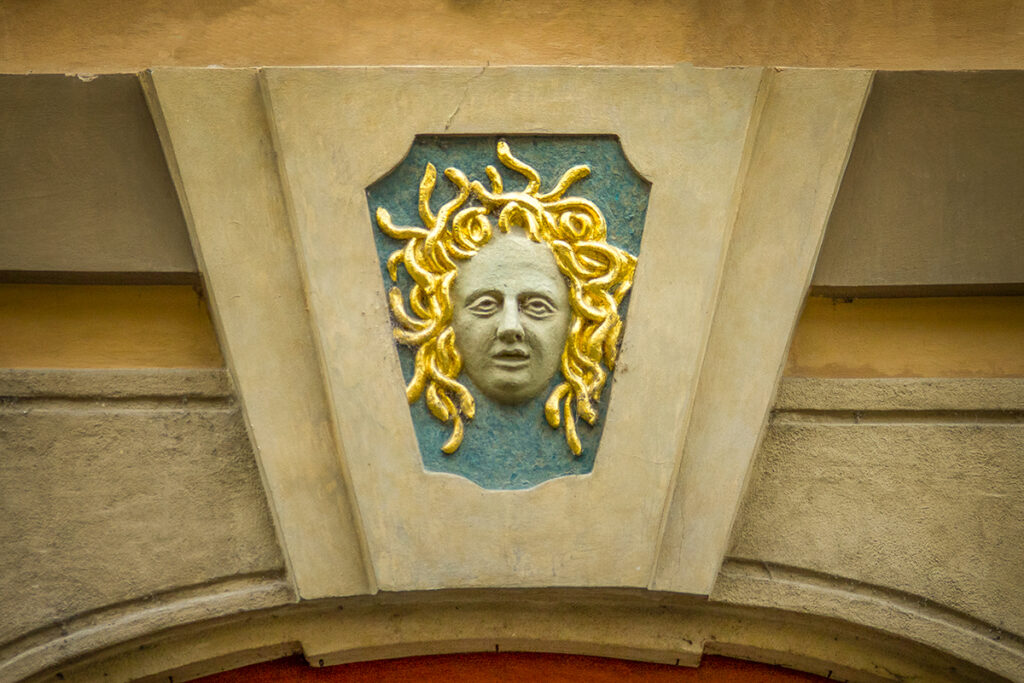
Strolling along Nerudova Street between Charles Bridge and Prague Castle, it is easy to become a little overwhelmed by the flamboyant Baroque facades and a constant flow of vehicle and pedestrian traffic. You might want to power through it. But I would recommend slowing down and exploring this street and its alleyways. You’ll find a few opportunities here to escape the crowds and discover some of Prague’s hidden gems.
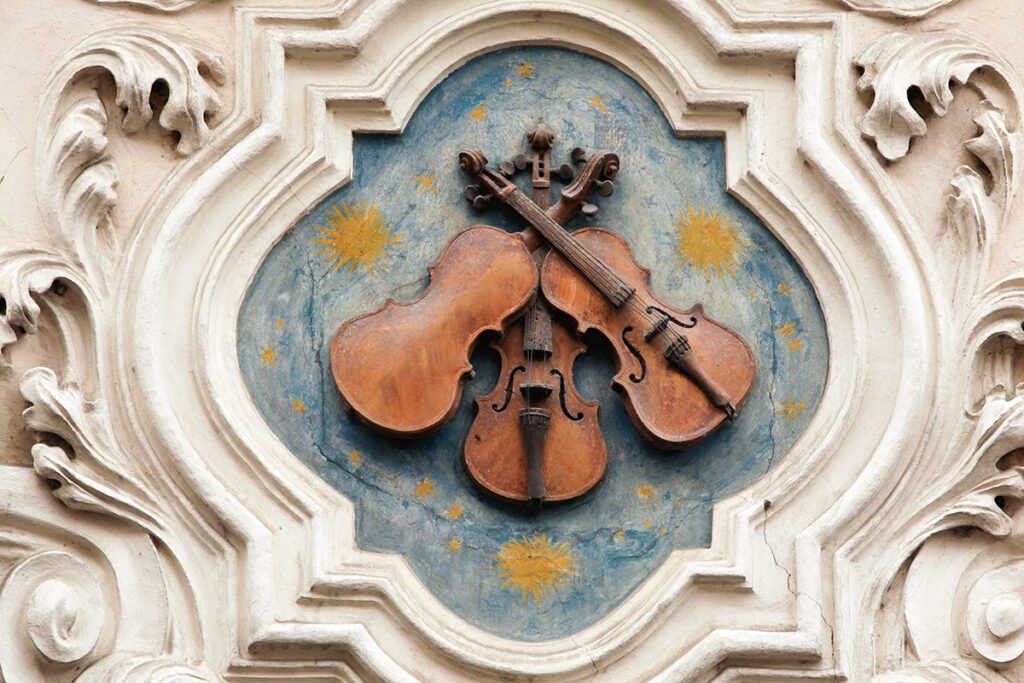
One such gem is the house signs along this street. These signs were used to identify houses before the current numbering convention was adopted. Look up above the doorways along Nerudova Street, and you will find a house at the White, a House at Medusa, and a House at the Golden Key. One of the most iconic house signs is one on the House at the Three Little Fiddles (Nerudova 211).
The history of the house dates to the Middle Ages, but the sign of three crossed violins is from the 18th century. It represented the three families of violin makers who owned the house from the late 17th century. As legend has it, you can still hear Paganini himself playing the violin in this house at night. Not a bad ghost to live with!
Jansky Vrsek Street
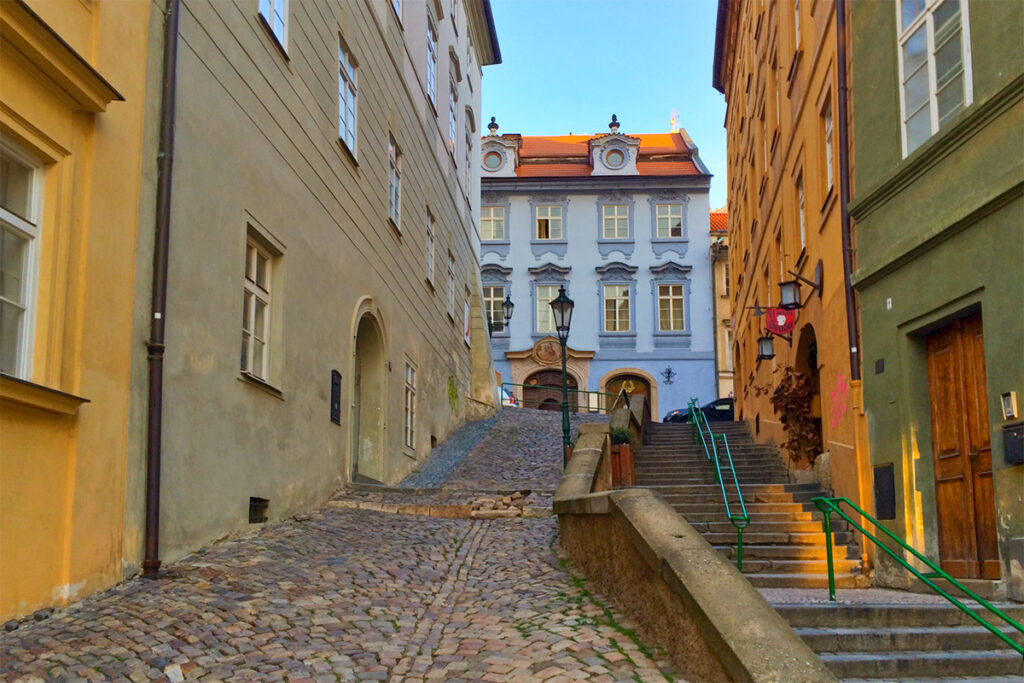
Another gem on Nerudova Street is the charming Jansky Vrsek Street, more of an alley, running uphill from Nerudova. At the start, the alley is split between a stairway and a cobbled street running parallel to each other. The brightly-coloured buildings on both sides of the street and further ahead make it appear very inviting despite its steepness.
Early in the morning, you can find yourself completely alone heading up Jansky Vrsek Street. And even in the middle of the day, you can find reprieve from the crowds here, especially if you walk further along.
And even if the good looks of the street are not enough, it also happens to lead to another quirky hidden gem in Prague – the Museum of Alchemists and Magicians.
The Museum of Alchemists and Magicians of Old Prague
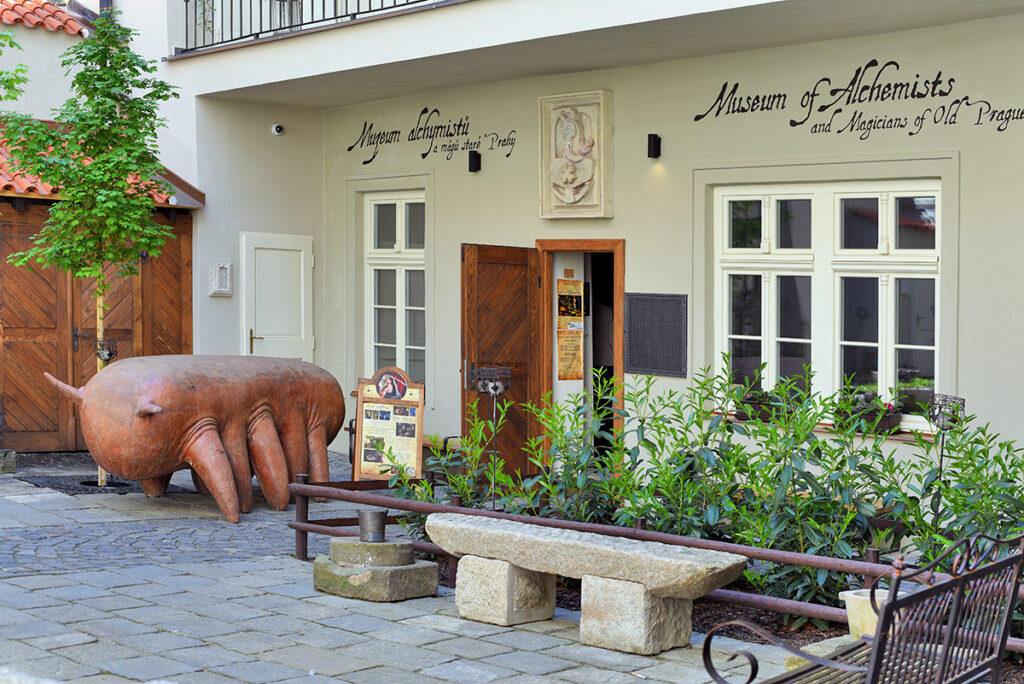
This off-beat museum is a real gem in Prague. It doesn’t just present exhibits, it takes you on a journey into a world of sorcery and ancient knowledge. First, you enter the mysterious room of Faust’s house, and then climb the sixty steps up a 16th-century staircase to the attic, where you find the laboratory of the famous alchemist Edvard Kelly who lived and worked in this house for the past three years of his life.
And once you are done exploring, there is a cozy Kellyxír – an alchemical Lab Pub that serves good wine, coffee, and cakes.
Thunovska Street
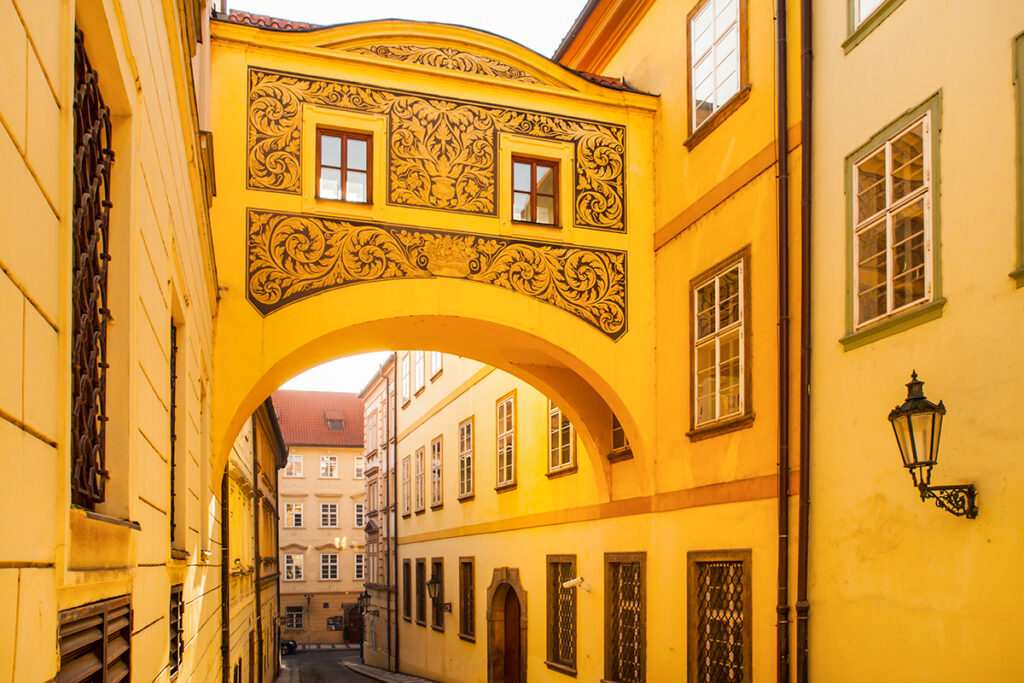
Thunovska Street is a picturesque narrow street connected to Nerudova street by the photogenic Prague Castle Stairs. It is a unique street in having three arches between its buildings, one of which is particularly ornamental.
Today, the street is called after Thunovsky Palace, which now houses the British Embassy, but it had many different names in the past. In the 14th century, it was called the Under the Water Well Street and in the 18th century it went by the name of Glazier Street, after the glass makers who lived and traded on this street.
In a city as old as Prague, many streets have long and colourful histories. Thunovska Street is believed to be haunted by the ghost of Antonio Salieri, and was used as one of the filming locations for the 1894 film Amadeus.
Stone Bell House
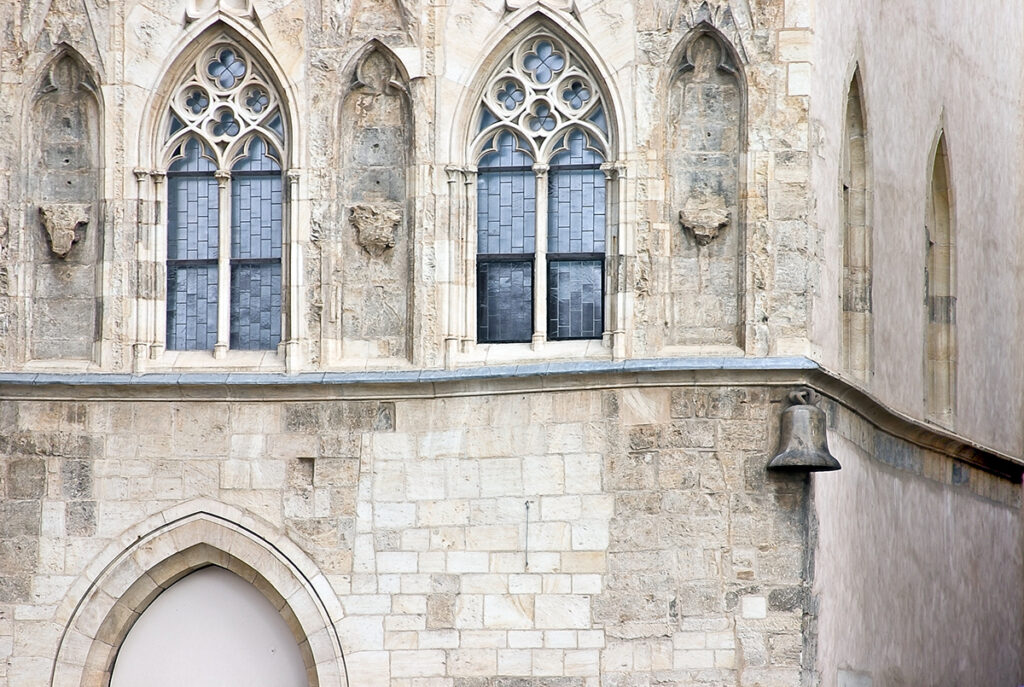
The curious thing about the Stone Bell House is the actual stone bell embedded in the outside corner. The bell could be a reminder of the arrival of John of Bohemia – a king of Bohemia (modern-day Czech Republic) and father of King Charles IV.
Originally the house was built in Gothic style, but during the Baroque era, a more flamboyant facade was added. This new Baroque facade lasted until the 1970s-80s when the original Gothic facade was revealed again.
The house is easy to find – it’s located on the corner of Old Town Square and Týnská Street. The stone bell is wedged into the external corner of the building at the top of the first floor.
The Rotunda of the Finding of the Holy Cross
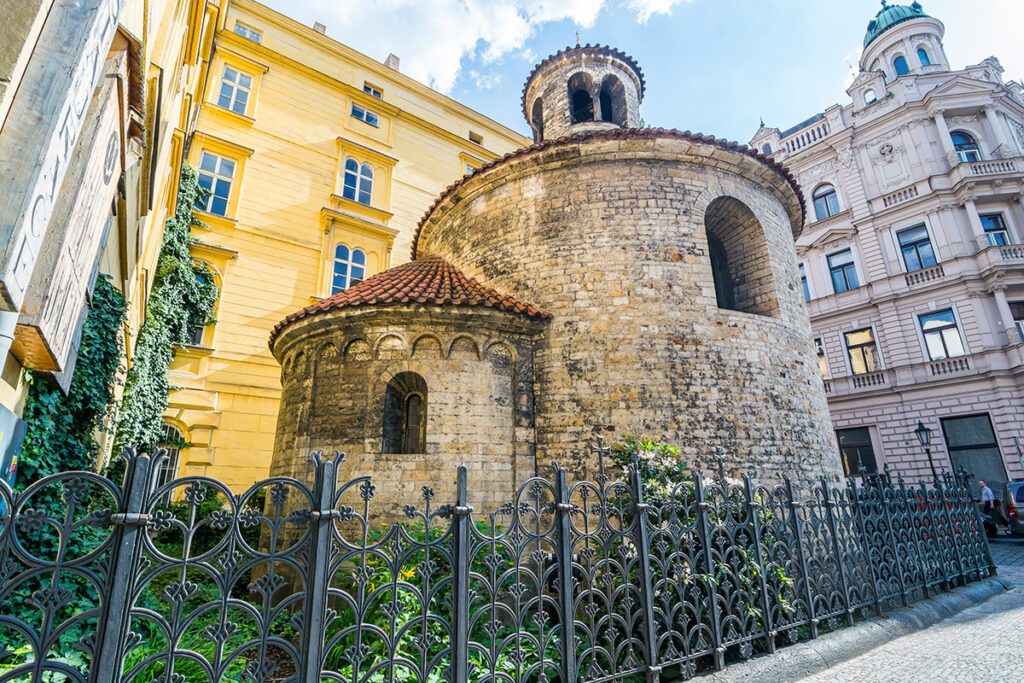
Rotunda of the Finding of the Holy Cross on the corner of Konviktská and Karolíny Světlé streets is one of the oldest buildings in Prague. Its origins date back to 1125.
According to the Official Tourist Website for Prague, the distinctly Romanesque Rotunda was built at the exact centre of the “urban cross” of old Prague, which connected the Cathedral of St Vitus, St Wenceslas and St Adalbert with the Rotunda of St Longin, the Church of St Clement in Old Town, and the now-destroyed Church of St Philip and St Jacob at Arbesovo náměstí.
Originally, the Rotunda May have been a private chapel belonging to an estate in Prague’s Old Town. The story behind the name of this Rotunda, The Finding of the Holy Cross’ refers to a Christian martyrdom legend. According to that legend, there used to be a lake in the spot where the rotunda stands. One day a girl was crucified for her Christian belief and her body, still nailed to the cross, was tossed into the lake.
When, during a storm, the cross reared up from the bottom of the lake, it was regarded as a sign from God. Which was probably interpreted as “Build a church here” rather than as “Stop crucifying people and throwing them into lakes”.
Interestingly, a large cross indeed was found in the foundations of the rotunda during restoration works.
Dum U Minute House
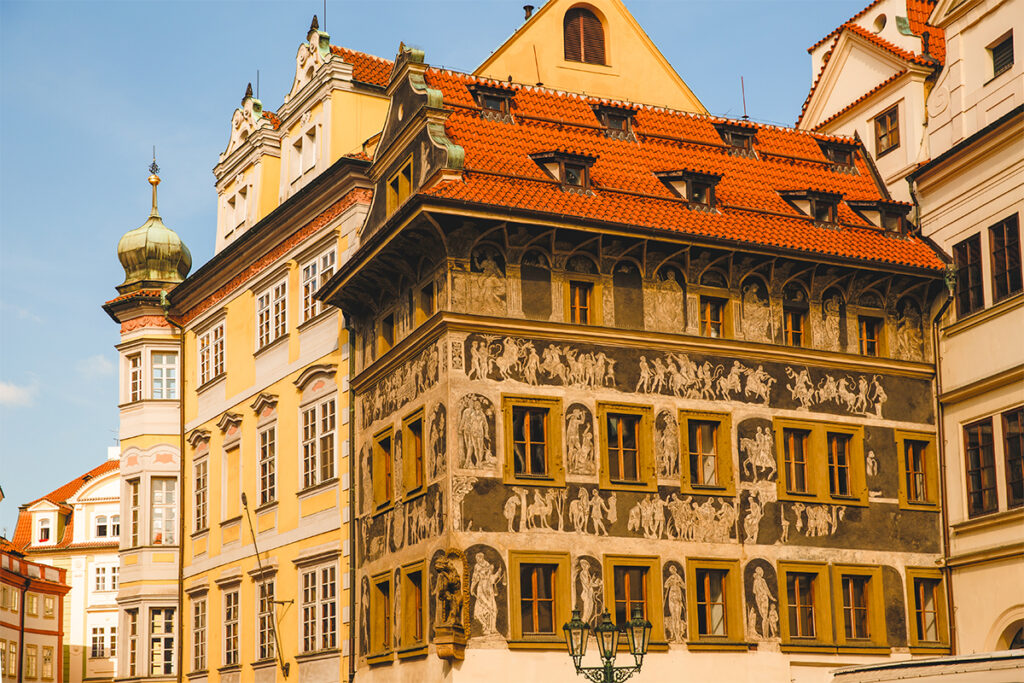
The House at the Minute (Staroměstské náměstí 3/2) is a lovely Renaissance pearl in Prague’s Old Town. The walls of the house are covered in intricate Sgraffito decorations that feature scenes from Greek mythology, the Bible, and various alchemy and occult symbols.
Sgraffito is a decorative technique where layers of tinted plaster are applied to the walls, and then parts of the top layer are scratched off to reveal the underlying layer of a different colour. This creates the appearance of an ornamental painting on the wall of a building.
The House at the Minute was built at the beginning of the 15th century, but the Sgraffito decorations were added in the early 17th century. During the Baroque era, the decorations were painted over and were only revealed in the 1920s.
The most famous residents of the House at the Minute were the Kafka family, who lived in an apartment on the second floor between 1889 and 1896
Strahov Library
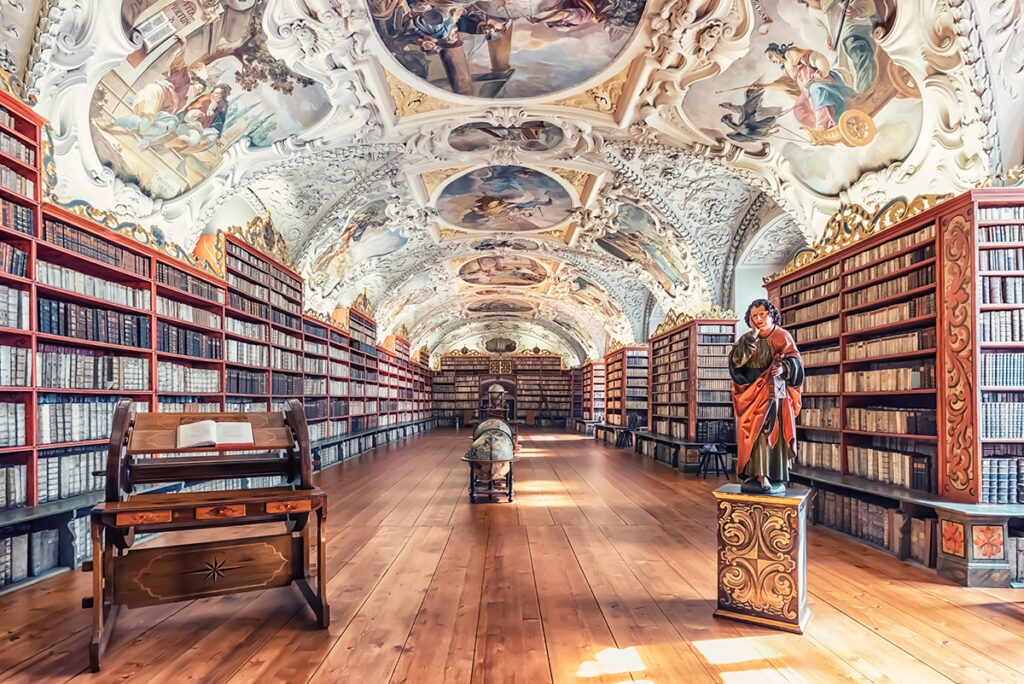
Finishing the list of hidden gems in Prague on a high note with one of the most spell-binding sites in the city. The exquisite Strahov library is housed in Strahov Monastery, just a short walk from Prague Castle. And if you take a slight detour to Novy Svet Street (number 1 on this list), you’ll discover two hidden gems in one walk.
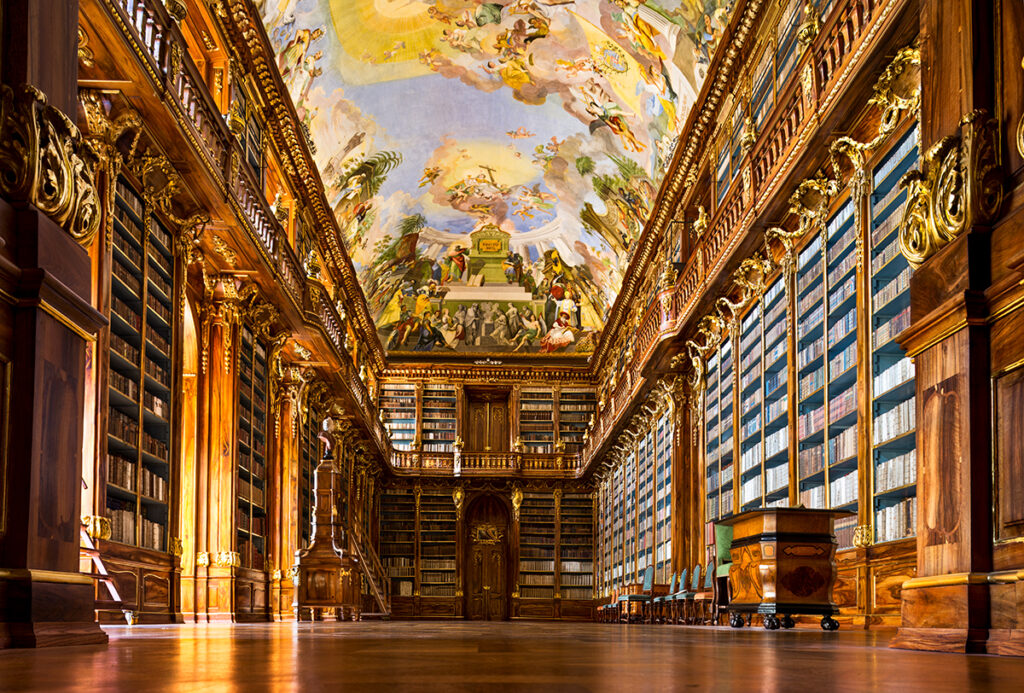
Tucked inside the white-washed walls of this 12th-century monastery, the Strahov Library is one of the most beautiful libraries of the old world. It is made up of two halls: Theological and Philosophical, and both these rooms are breathtaking.
And there you have it, 12 quirky and charming hidden gems in Prague that hide in plain view, overshadowed by the more famous architectural masterpieces. All of them are easy to discover on your strolls around Prague.

